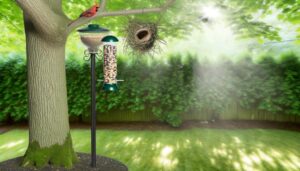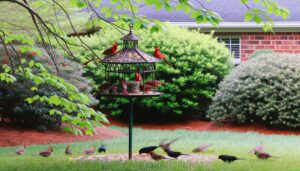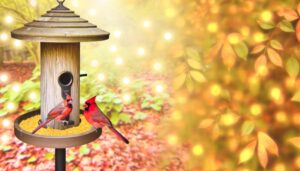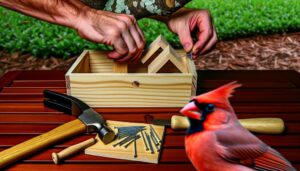10 Easy Steps to Hang a Cardinal Feeder
To hang a cardinal feeder, choose a sturdy feeder with large perches and secure a rust-resistant hook. Mount the hook at a height of 5-7 feet to improve visibility and protect against predators.
Use a hook that surpasses the feeder's weight capacity and drill a pilot hole for a snug fit. Place feeders near vegetation for cover but away from low branches to discourage predators.
For best food supply, prioritize black-oil sunflower and safflower seeds. Install a metal baffle to keep squirrels away.
Clean the feeder bi-weekly with a 10% bleach solution. Keep monitoring for effective feeding strategies.
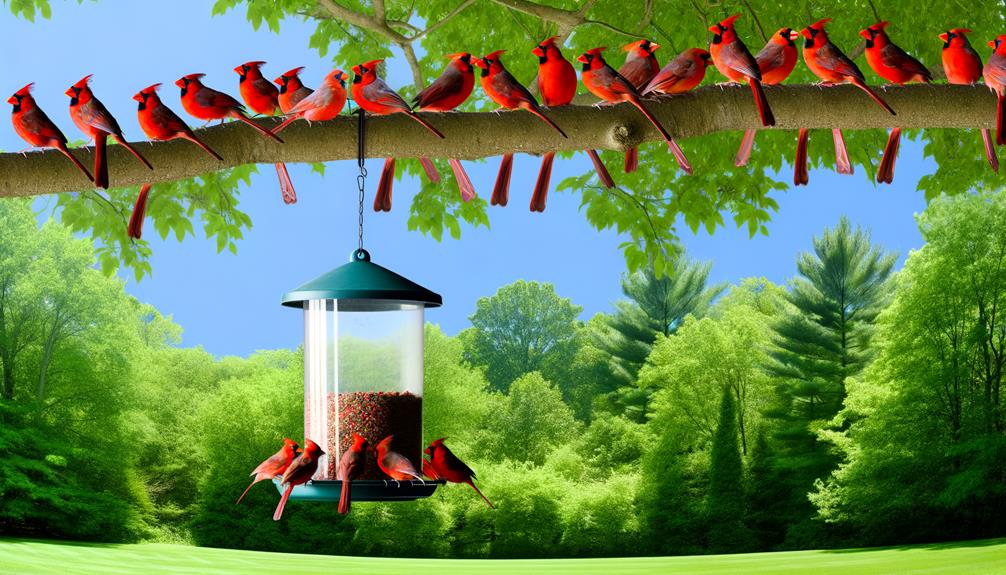
Key Takeaways
- Secure a sturdy, galvanized or stainless-steel hook rated for the feeder's weight.
- Mount the feeder at a height of 5 to 7 feet for optimal cardinal visibility and safety.
- Position the feeder near vegetation for cover but away from predator threats.
- Install a metal baffle below the feeder to deter squirrels.
- Ensure the feeder is stable and easy to access for refilling and cleaning.
Choosing the Right Feeder
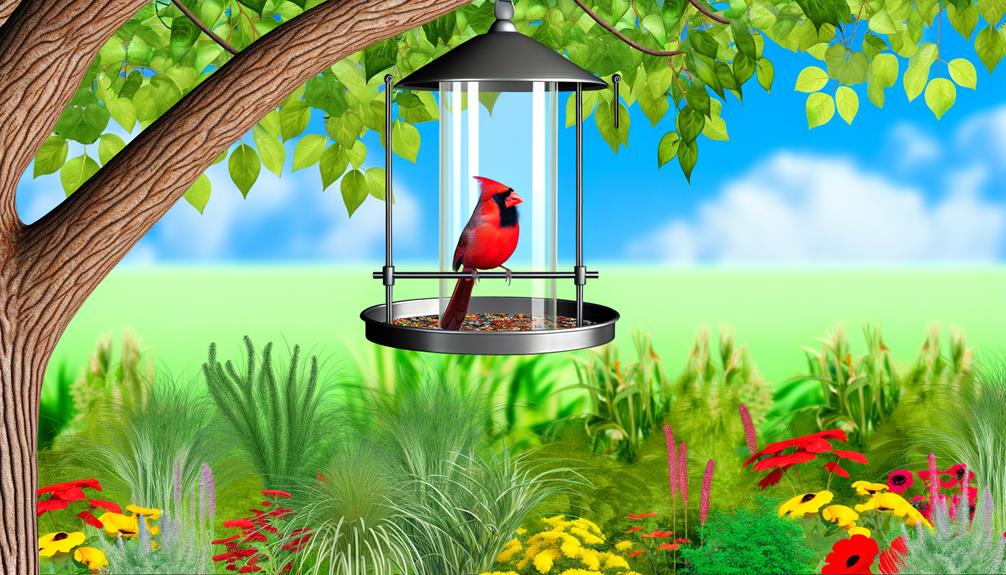
Selecting the fitting cardinal feeder requires understanding their feeding habits and preferences. Cardinals favor feeders that can accommodate their medium size and strong beaks. Choose a feeder with a robust perch and ample feeding ports, as cardinals often need space to sit comfortably while feeding.
Scientific observations indicate that tube feeders with large perches or hopper feeders are ideal. The feeder's material should be durable, weather-resistant, and easy to clean to prevent mold growth, ensuring an excellent feeding environment. Data shows that cardinals are attracted to feeders placed at heights of 5-6 feet, away from predators.
Opt for a feeder design that minimizes spillage, conserving food and maintaining a tidy area. Prioritize these attributes to enhance your cardinals' feeding experience.
Selecting the Best Food
When choosing the ideal food for cardinals, prioritize seeds such as sunflower and safflower. Data shows they prefer these seeds due to their nutritional content and ease of handling with their strong beaks. These seeds provide essential fats and proteins vital for their energy needs and overall health. Additionally, cardinals are known to favor certain types of food, enhancing your feeder's attractiveness.
- Black-oil sunflower seeds: High in fat, easy for cardinals to crack open.
- Safflower seeds: Nutrient-rich, less appealing to other bird species.
- Peanuts: Offer high protein and fat content, beneficial for muscle maintenance.
- Cracked corn: Serves as a supplementary food source, providing carbohydrates.
Finding the Optimal Location
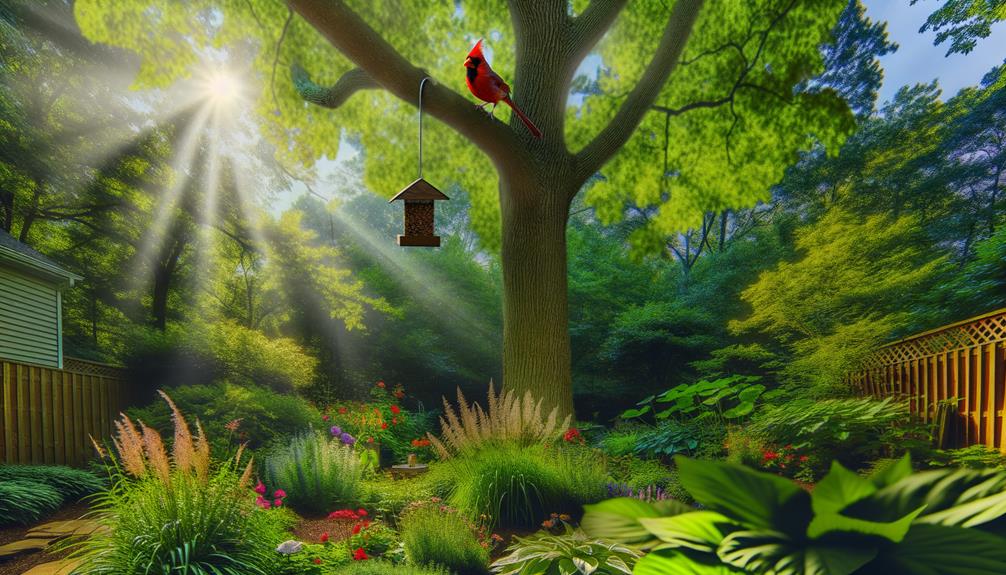
To find the best location for your cardinal feeder, assess nearby vegetation to guarantee sufficient cover and foraging opportunities.
Consider predator risks by measuring the distance from potential threats, such as cats or hawks, and aim for a height of at least 5-6 feet.
Utilizing these data points will improve feeder use and bird safety.
Assess Nearby Vegetation
Begin by assessing the density, height, and species of nearby vegetation to confirm that the cardinal feeder is positioned in a way that maximizes visibility and accessibility for birds.
Thick foliage can obstruct the feeder, making it less appealing to cardinals. Measure the height of shrubs and trees to verify the feeder isn't too high or too low.
Consider the following elements:
- Vegetation Density: Scant plant life enhances feeder visibility.
- Plant Species: Choose native plants that attract cardinals.
- Leaf Coverage: Seasonal changes in foliage might affect feeder access.
- Proximity to Perches: Make sure nearby branches offer perching spots for cardinals.
Consider Predator Risks
Mitigating predator risks involves strategically placing the cardinal feeder to minimize threats from cats, hawks, and other potential predators. Position the feeder at least 10 feet away from dense vegetation to deter ambush-style attacks from cats.
For aerial predators like hawks, hang the feeder under a canopy or near tree branches that provide cover, reducing visibility from above. Data indicates a height of 5-6 feet is ideal; it's too high for cats and still within a cardinal's preferred feeding range.
Make sure the feeder is securely fastened to prevent it from falling, which could attract ground predators. By considering these scientific guidelines, you'll create a safe feeding environment, allowing cardinals to thrive while maintaining your freedom from constant vigilance.
Ensuring Proper Height
Mount the cardinal feeder at a height between 5 to 7 feet to ensure excellent visibility and protection from predators. Scientific studies indicate that this height maximizes birdwatching opportunities and reduces predation risk.
You must also consider the following for best placement:
- Feeder Stability: Guarantee the feeder remains stable in windy conditions.
- Accessibility: Make sure you can easily refill and clean the feeder.
- Predator Deterrence: Position it away from low-hanging branches where predators might lurk.
- Visibility: Place it where you and the cardinals can easily spot it.
Installing a Sturdy Hook
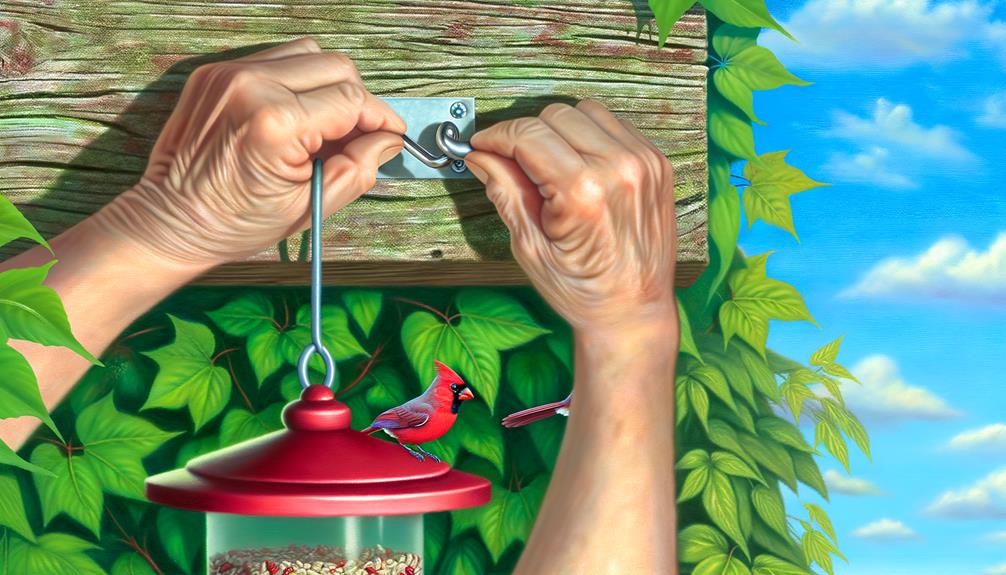
After confirming the ideal height for your cardinal feeder, secure a sturdy hook capable of supporting the feeder's weight and withstanding environmental stressors. Opt for a galvanized or stainless-steel hook due to their superior strength and corrosion resistance. Confirm that the hook's load capacity exceeds the feeder's weight, including seeds and potential bird traffic.
| Hook Material | Load Capacity (lbs) | Corrosion Resistance |
|---|---|---|
| Galvanized Steel | 50 | High |
| Stainless Steel | 75 | Very High |
| Aluminum | 30 | Moderate |
Drill a pilot hole slightly smaller than the hook's diameter to ensure a snug fit. Use a threaded hook for improved holding power. This method reduces movement and secures your feeder against wind and other external forces, guaranteeing stability and durability.
Keeping Squirrels Away
To effectively prevent squirrels from accessing your cardinal feeder, consider installing a baffle with a diameter of at least 18 inches below the feeder. This size is ideal because it exceeds the average squirrel's jump range, which is approximately 10 to 12 inches.
Additionally, utilize the following strategies:
- Placement: Position the feeder at least 10 feet away from trees or structures, as squirrels can leap horizontally.
- Material: Opt for a metal baffle; squirrels can't chew through it.
- Height: Mount the feeder at least 5 feet off the ground to deter ground-based approaches.
- Lubrication: Apply a non-toxic lubricant like petroleum jelly to the feeder pole to create a slippery surface.
Employing these methods ensures your cardinal feeder remains squirrel-free, maximizing bird-watching enjoyment.
Maintaining Cleanliness
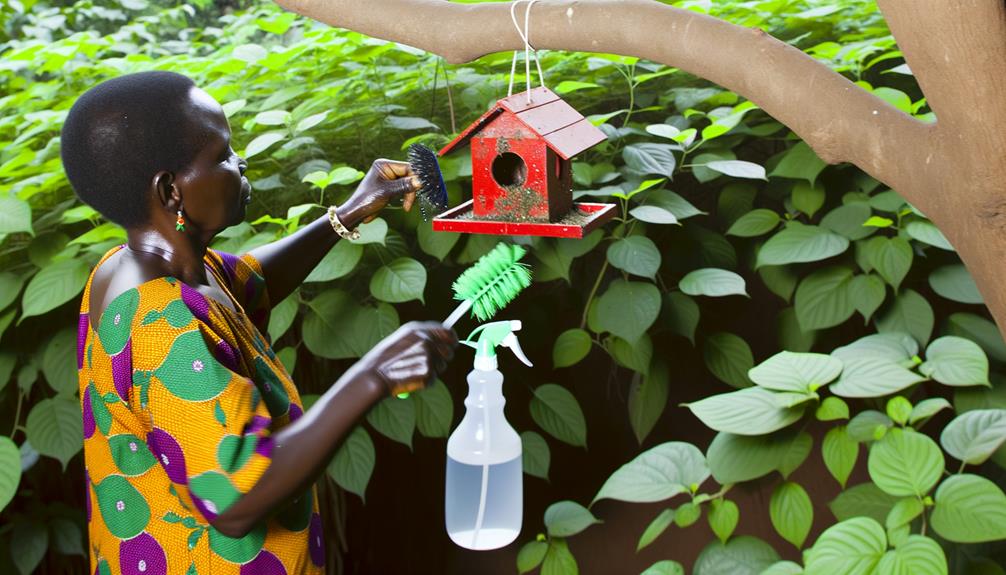
Regularly cleaning your cardinal feeder is essential for preventing mold growth and the spread of diseases among birds. To maintain peak hygiene, clean the feeder every two weeks or more frequently during humid conditions.
Use a 10% bleach solution (one part bleach to nine parts water) to disinfect thoroughly. Rinse the feeder with clean water to eliminate any bleach residue, ensuring it's completely dry before refilling.
Inspect the feeder for any leftover seeds or debris, as these can harbor harmful bacteria. Data shows that regular cleaning can reduce pathogen transmission by 50%.
Prioritize cleanliness to provide a safe feeding environment, ensuring the well-being of cardinals and other visiting birds. Your dedication to hygiene helps maintain a healthy bird population.
Monitoring Bird Activity
To effectively monitor bird activity at your feeder, track daily visit patterns by recording the frequency and time of cardinal visits.
Use species identification tips to distinguish cardinals from other birds, focusing on unique markers such as plumage and calls.
For behavioral observations, note feeding habits and interactions to gather detailed data on cardinal activity.
Daily Visit Patterns
Monitoring the daily visit patterns of cardinals to your feeder provides valuable data on their feeding habits and peak activity times. You should log observations systematically, focusing on key metrics to guarantee data integrity.
- Time of Day: Track the specific hours cardinals are most active.
- Frequency: Record the number of visits per day to identify trends.
- Duration: Measure how long cardinals stay at the feeder per visit.
- Weather Conditions: Note weather variables to associate with activity.
Species Identification Tips
Accurately identifying bird species at your feeder requires a systematic approach, focusing on distinct visual and auditory characteristics. Begin by observing plumage color, beak shape, and size. Listen closely for unique calls. Use a field guide or app to cross-reference your observations.
| Trait | Cardinal |
|---|---|
| Plumage | Bright red (males), tan (females) |
| Beak Shape | Thick, cone-shaped |
| Size | 21-23 cm |
| Song | Clear, whistled phrases |
| Behavior | Often seen in pairs |
Recording your sightings systematically will enhance accuracy. Note the time, date, and weather conditions. Incorporate these data points into a log to track patterns and frequency. This methodical approach not only aids in identification but also contributes to broader ornithological studies.
Behavioral Observations Tips
Once you've logged species identification data, start monitoring cardinal behavior by noting feeding patterns, social interactions, and nesting activities.
Pay close attention to:
- Feeding times: Document the specific times cardinals visit the feeder.
- Social behavior: Observe interactions, noting any aggressive or cooperative behaviors.
- Nesting: Identify nesting sites and frequency of visits.
- Vocalizations: Record different calls and their contexts.
Consistently collect data at regular intervals to identify trends.
Use a notebook or digital app for precise data entry.
Comparing your findings with existing ornithological studies can provide deeper insights into cardinal behavior.
Seasonal Adjustments
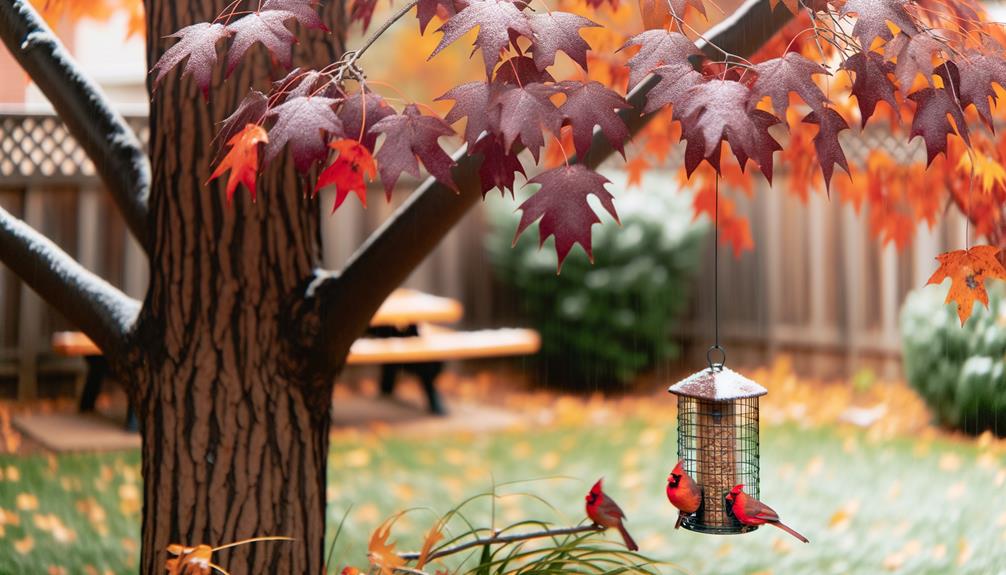
Adjusting your cardinal feeder for seasonal changes maximizes ideal feeding conditions and enhances bird activity throughout the year.
In winter, position the feeder near shrubs to provide wind protection and thermal cover, crucial for cardinals enduring temperatures below 20°F. Switch to high-fat seeds like sunflower and safflower to meet increased metabolic demands.
During spring, elevate the feeder to prevent predation during nesting periods.
Summer requires frequent cleaning—every two days—to prevent mold and bacteria growth as temperatures exceed 70°F.
In autumn, keep the feeder stocked to support pre-migratory fattening. Even though cardinals are non-migratory, they require substantial energy reserves.
Adapting to these seasonal requirements enhances cardinals' health and boosts their presence in your outdoor space.
Conclusion
You've selected the right feeder, chosen the best food, and found the ideal location. By ensuring proper height and installing a sturdy hook, you've set the stage for success.
Squirrel-proofing strategies and strict cleanliness keep your setup secure and sanitary. Monitor bird activity meticulously and make necessary seasonal adjustments.
By following these scientifically sound steps, you've created a bird-friendly environment that enhances cardinal visits, ensuring vibrant views and valuable data on avian activity.

